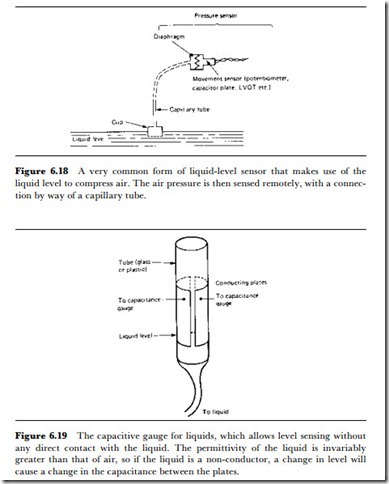Liquid levels
A sample of liquid has a mass that is fixed, and a volume that changes slightly with changes of temperature. The shape of a liquid is, in general, the shape of its container, although in zero gravity most liquids take the shape of least surface area, a sphere. The measurement or sensing of the level of a liquid in a container of uniform cross-section is therefore a useful quantity that is proportional to the volume of the liquid.
The simplest form of liquid-level gauge is based on the ancient float-and- arm system, as illustrated in Figure 6.17. Any suitable transducer can be used to detect the angular movement of the arm, and a potentiometer is particularly useful. With a fixed voltage, AC or DC, applied to the fixed ends of the potentiometer, the voltage at the variable tap will be proportional to the position of the float between the low and high extremes.
The float system is less attractive if the liquid is corrosive. Although the float itself, and the arm, can be made from resistant material such as polypropylene, the transducer is still liable to damage from corrosive vapours, and a potentiometer is unlikely to be useful. The LVDT principle can be used, with the metal plunger encased in plastic and the wires also insulated with plastic, but other methods are usually preferable in such circum- stances.
One other method is the air-compression sensor (Figure 6.18). A tube is immersed in the liquid so that air (or possibly another liquid) is trapped inside the tube. A change in the liquid level outside the tube will cause the air to be compressed or expanded, and this change of pressure can be sensed. A scheme like this is often used to sense water level in clothes-washers and dishwashers. For switching purposes, a diaphragm and microswitch can be used, but in order to sense the level the transducer should be a manometer or similar pressure detector (see Chapter 1).
A very neat method that can be applied to any liquid, makes use of the permittivity of the liquid that will cause a change of capacitance if the
liquid is placed between capacitor plates. The scheme is illustrated in Figure 6.19, showing the transducer as a pair of rectangular foil plates wrapped around a tube so that the edges do not quite touch. These plates now form a capacitor for which the content of the tube acts as a dielectric. Replacing the air in the tube by a liquid will cause a change of capacitance due to the different permittivity of the liquid. The amount of the change will be pro- portional to the level of liquid in the tube between the limits of the length of the capacitor plates.
The change of capacitance is most easily sensed by making the capacitor part of an oscillating circuit. Some care is needed if the liquid is a partial conductor, as this can damp the oscillation and cause the oscillator to stop. The change of capacitance causes a change of oscillating frequency, with the frequency falling as the liquid rises, and this change of frequency can be converted into a voltage by a frequency discriminator or by a digital- analogue converter.

